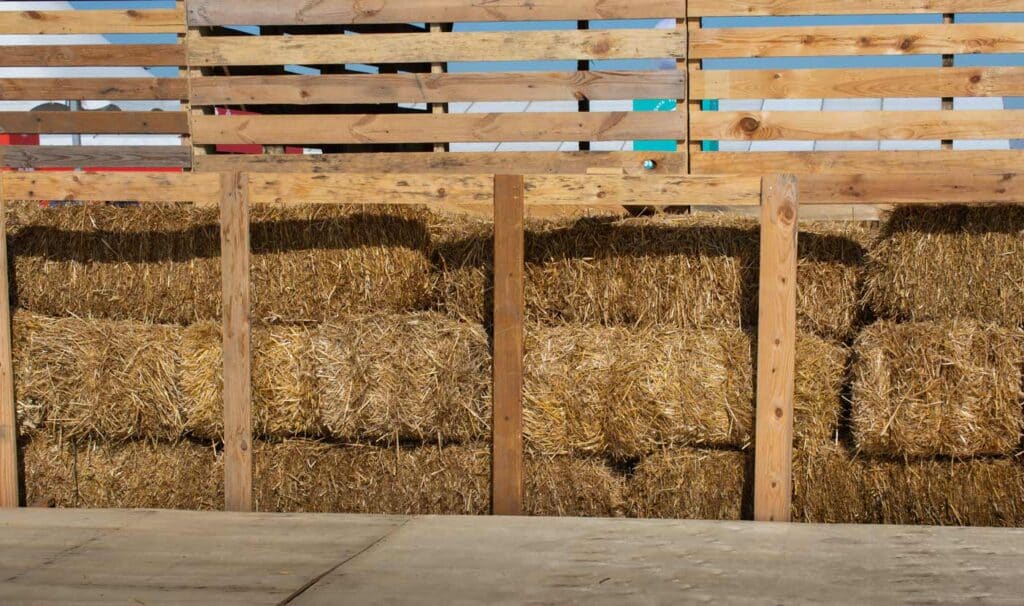Top Tips for Storing Hay to Maintain Quality and Nutritional Value
Welcome to our comprehensive guide on storing hay to preserve its quality and nutritional value. Whether you’re storing hay in garage, plastic container, shipping container, or even at night or in a car, we’ve got you covered with expert tips to ensure your hay stays fresh and nutrient-rich.

(Hay bales are stacked large stacks forming wall)
Choosing the Right Storage Space
When selecting the appropriate storage space for your hay, it’s crucial to prioritize ventilation, as inadequate airflow can lead to moisture accumulation and subsequent mold growth. Hay is highly susceptible to moisture, which can compromise its quality and nutritional value over time. Therefore, opt for a well-ventilated area within your garage or any enclosed space. This could involve installing vents or ensuring that windows or doors can be opened to allow air circulation. Additionally, choose a location that is dry and cool, as high temperatures can accelerate the breakdown of hay and promote mold development. Direct sunlight should also be avoided, as it can cause overheating and moisture condensation within the storage area. By selecting a storage space that prioritizes proper ventilation, dryness, and cool temperatures, you can significantly reduce the risk of mold growth and maintain the quality of your stored hay for longer periods proving a better balanced diet for your animals.
Storing Hay in Plastic Containers
When opting for plastic containers to store smaller quantities of hay, attention to cleanliness and dryness is paramount. Begin by ensuring that the plastic containers you choose are thoroughly cleaned and completely dry before placing any hay inside. This step is crucial in preventing contamination, as any moisture or residue left in the containers can facilitate mold growth or attract pests. Once the containers are clean and dry, securely seal them with lids to create an airtight environment for the hay. This helps to maintain its freshness and nutritional integrity by minimizing exposure to external elements such as humidity and dust. Additionally, labeling the containers with the date of storage can aid in keeping track of the hay’s freshness and rotation. By following these steps when using plastic containers for hay storage, you can effectively safeguard its quality and ensure that it remains in optimal condition until it’s needed for use.
Utilizing Shipping Containers
When considering storing hay in shipping container, several key factors should be taken into account to maintain the quality and longevity of the stored hay. Firstly, it’s essential to ensure that the shipping container is thoroughly cleaned and completely dry before loading any hay into it. This precaution helps to prevent contamination and mold growth, as any residual moisture or debris could compromise the hay’s integrity.
Moreover, ventilation is crucial when utilizing shipping containers for hay storage. While these containers offer a secure and enclosed environment, they can also be prone to condensation buildup, especially in areas with fluctuating temperatures or high humidity levels. To mitigate this risk, consider incorporating ventilation systems such as vents or fans to promote air circulation within the container. This airflow helps to prevent the accumulation of moisture, which can lead to mold growth and degradation of the hay’s quality.
Nighttime Storage
When storing hay at night, it’s essential to take additional precautions to safeguard it against potential threats such as moisture and pests. Selecting a secure storage location is the first step in ensuring the hay remains protected. Choose an area that is not only secure from theft or vandalism but also offers adequate protection from environmental elements like moisture and pests. Covering the hay with a tarp or plastic sheet is crucial to shield it from dew or rain that may occur overnight. Even in relatively dry climates, dew can accumulate on surfaces during the cooler nighttime temperatures, potentially leading to moisture absorption by the hay. By covering the hay with a waterproof barrier, you create a protective shield that helps prevent moisture from penetrating and compromising its quality.
Storing Hay in a Car
Storing hay in a car is not the most preferred option, but there are instances where it becomes necessary, particularly during transport. When faced with this situation, it’s crucial to take certain precautions to minimize mess, odors, and potential damage to both the hay and the vehicle.
First and foremost, containment is key. To prevent hay from scattering and creating a mess in your car, pack it in sturdy plastic bags or bins. This not only helps to keep the hay contained but also prevents the spread of odors that may result from handling or transporting hay.
Furthermore, maintaining cleanliness is essential when storing hay in a car. After transporting the hay, thoroughly clean the interior of the vehicle to remove any stray pieces of hay, dust, or residue. This not only helps to keep your car clean and odor-free but also prevents the attraction of pests that may be drawn to leftover hay or debris.
Conclusion
By following these top tips for storing hay, whether it’s in a garage, plastic container, shipping container, at night, or in a car, you can maintain its quality and nutritional value for longer periods. Remember to prioritize proper ventilation, cleanliness, and protection from moisture and pests to ensure your hay remains fresh and nutritious.

